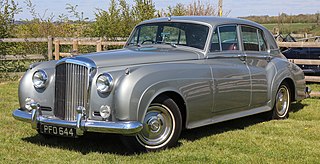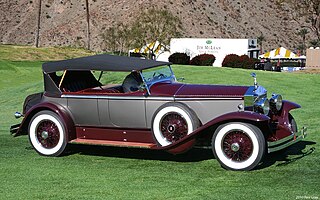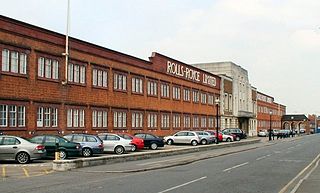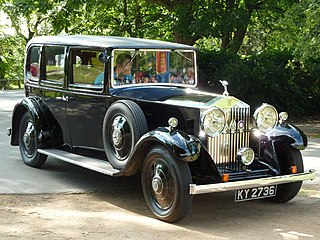Bentley Motors Limited is a British designer, manufacturer and marketer of luxury cars and SUVs. Headquartered in Crewe, England, the company was founded by W. O. Bentley (1888–1971) in 1919 in Cricklewood, North London, and became widely known for winning the 24 Hours of Le Mans in 1924, 1927, 1928, 1929 and 1930. Bentley has been a subsidiary of the Volkswagen Group since 1998 and consolidated under VW's premium brand arm Audi since 2022.

The Rolls-Royce Silver Cloud is a luxury automobile produced by Rolls-Royce Limited from April 1955 to March 1966. It was the core model of the Rolls-Royce range during that period. The Silver Cloud replaced the Silver Dawn and was, in turn, replaced by the Silver Shadow. The John P. Blatchley design was a major change from the pre-war models and the highly derivative Silver Dawn. As part of a range rationalisation, the Bentley S1 was made essentially identical, apart from its radiator grille and badging.

The Bentley S1 was a luxury car produced by Bentley Motors Limited from 1955 until 1959. The S1 was derived from Rolls-Royce's complete redesign of its standard production car after World War II, the Silver Cloud. Each was its maker's last standard production car with an independent chassis. The S-series Bentley was given the Rolls-Royce - Bentley L Series V8 engine in late 1959 and named the S2. Twin headlamps and a facelift to the front arrived in late 1962, resulting in the S3. In late 1965, the S3 was replaced by the new unitary construction Rolls-Royce Silver Shadow-derived T series.

The Bentley Mark VI is an automobile from Bentley which was produced from 1946 until 1952.

The Bentley R Type is the second series of post-war Bentley automobiles, produced from 1952 to 1955 as the successor the Mark VI. Essentially a larger-boot version of the Mk VI, the R type is regarded by some as a stop-gap before the introduction of the S series cars in 1955. As with its predecessor, a standard body was available as well as coachbuilt versions by firms including H. J. Mulliner & Co., Park Ward, Harold Radford, Freestone and Webb, Carrosserie Worblaufen and others.

The Bentley S2 is a luxury car produced by Bentley from 1959 until 1962. The successor to the S1, it featured the new Rolls-Royce–Bentley L-series V8 engine and improved air conditioning made possible by that engine's increased output. Power steering was also standard, and a new dashboard and steering wheel were introduced. Some early S2s were built with the earlier S1 dashboard.

Bentley Continental refers to several models of cars produced by Bentley Motors. Originally, it referred to a special chassis for engines more powerful than the usual offering, supplied to a selected number of coachbuilders for the fitting of very light-weight coachwork designed under Rolls-Royce supervision.

The Silver Wraith was the first post-war Rolls-Royce. It was made from 1946 to 1958 as only a chassis at the company's Crewe factory, its former Merlin engine plant, alongside the shorter Bentley Mark VI. The Bentley was also available as a chassis for coachbuilders, but for the first time could be bought with a Rolls-Royce built Standard Steel body. The use of the name "wraith" coincided with the established tradition of naming models after "ghosts".

The Rolls-Royce Phantom IV is a British automobile produced by Rolls-Royce. Only eighteen were made between 1950 and 1956, sold only to buyers whom Rolls-Royce considered worthy of the distinction: the British royal family and heads of state. Sixteen are known to still exist in museums as well as in public and private collections.

The Rolls-Royce Phantom VI is a British limousine made from 1968 to 1990 by Rolls-Royce. A total of 374 Phantom VIs were made, of which fewer than 40 were manufactured in the last decade of production.

The Rolls-Royce Phantom was Rolls-Royce's replacement for the original Silver Ghost. Introduced as the New Phantom in 1925, the Phantom had a larger engine than the Silver Ghost and used pushrod-operated overhead valves instead of the Silver Ghost's side valves.

The Bentley 3½ Litre was a luxury car produced by Bentley from 1933 to 1939. It was presented to the public in September 1933, shortly after the death of Henry Royce, and was the first new Bentley model following Rolls-Royce's acquisition of the Bentley brand in 1931.

The Bentley Mark V was Rolls-Royce's second Bentley model. Intended for announcement at the Earl's Court Motor Show set down for late October 1939 it had much in common with its predecessor. War was declared on 3 September 1939 and a few days later Bentley announced it had ceased production of civilian items.
Park Ward was a British coachbuilder founded in 1919 which operated from Willesden in North London. In the 1930s, backed by Rolls-Royce Limited, it made technical advances which enabled the building of all-steel bodies to Rolls-Royce's high standards. Bought by Rolls-Royce in 1939, it merged with H. J. Mulliner & Co. in 1961 to form Mulliner Park Ward.

The Rolls-Royce Wraith was built by Rolls-Royce at their Derby factory from 1938 to 1939 and supplied to independent coachbuilders as a rolling chassis.

Rolls-Royce Limited was a British luxury car and later an aero-engine manufacturing business established in 1904 in Manchester by the partnership of Charles Rolls and Henry Royce. Building on Royce's good reputation established with his cranes, they quickly developed a reputation for superior engineering by manufacturing the "best car in the world". The business was incorporated as "Rolls-Royce Limited" in 1906, and a new factory in Derby was opened in 1908. The First World War brought the company into manufacturing aero-engines. Joint development of jet engines began in 1940, and they entered production in 1944. Rolls-Royce has since built an enduring reputation for the development and manufacturing of engines for military and commercial aircraft.

The Rolls-Royce 20/25 is the second of Rolls-Royce Limited's inter-war entry-level models. Built between 1929 and 1936, it was very popular, becoming the most successful selling inter-war Rolls-Royce. Its success enabled Rolls-Royce to survive the Great Depression, and remain one of World's great brands. 3,827 20/25s were produced, and more than 70% of these survive in use.

John Polwhele Blatchley was a London-born car designer known for his work with J Gurney Nutting & Co Limited and Rolls-Royce Limited. He began his career as designer with Gurney Nutting in 1935, moving up to Chief Designer before leaving in 1940 to join Rolls-Royce. There he served as a draughtsman (1940–43), stylist in the car division (1943–55), and chief styling engineer (1955–69).

Barker & Co. was a British coachbuilder, a maker of carriages and in the 20th century bodywork for prestige cars, including Rolls-Royce, Bentley, and Daimler.
William Arthur Robotham was a Rolls-Royce executive involved in the development of Rolls-Royce cars, during World War II of tanks and tank engines, and post-war of Rolls-Royce and Bentley cars complete with bodies and then of industrial petrol and diesel engines.





















